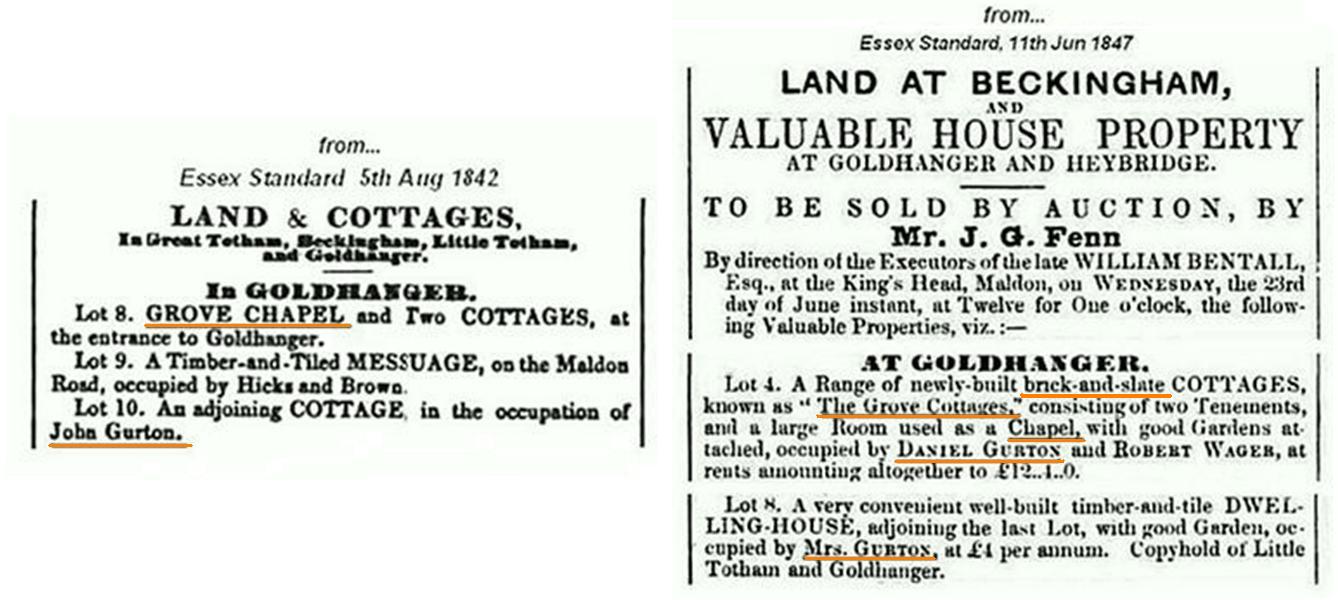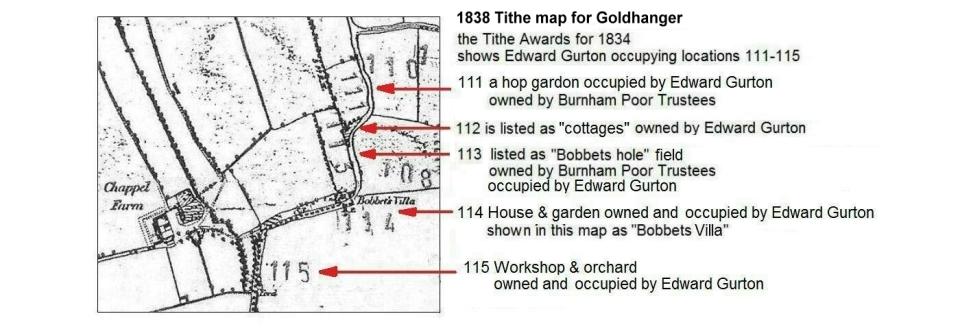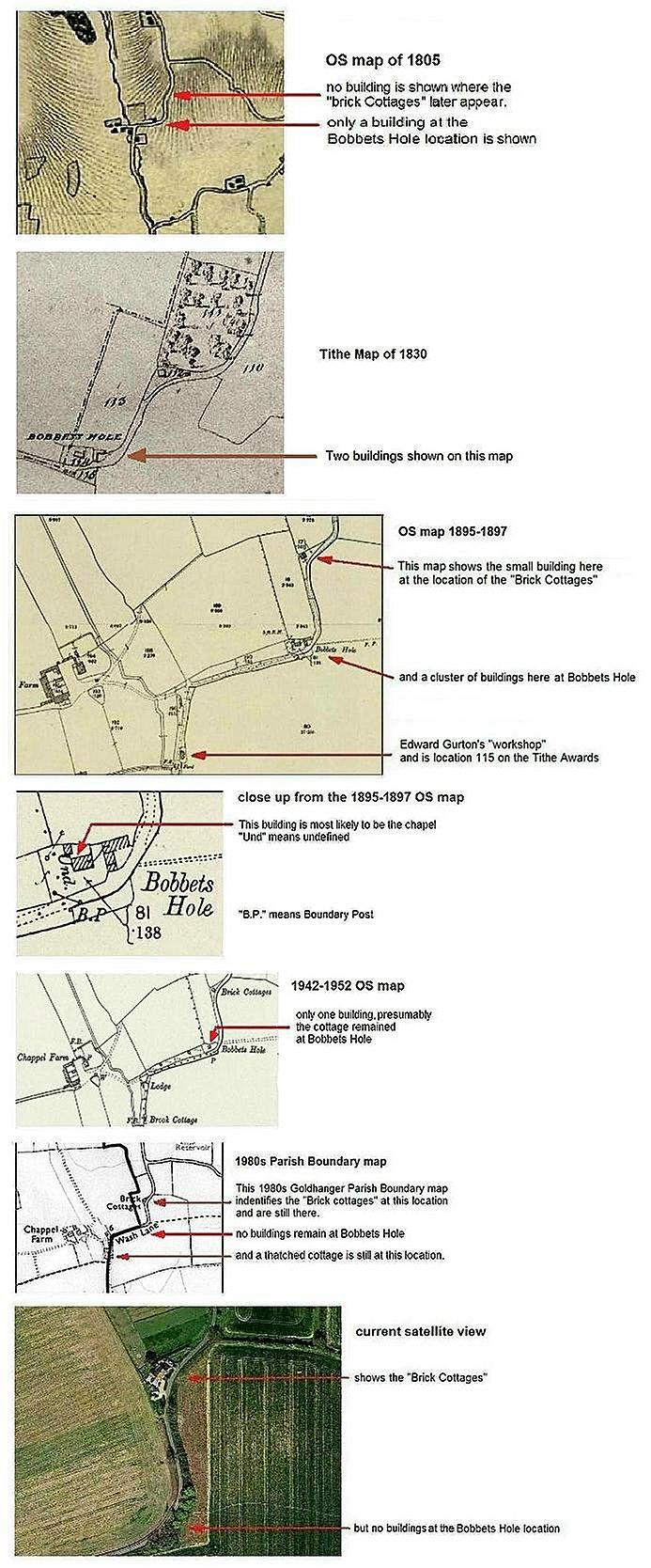The
Chapel near Chappel farm
There is now strong
evidence that a chapel once existed close to Chappel Farm. The farm undoubtedly
acquired its name from its association with the chapel. The farm has always
been in Little Totham parish, the chapel however was just over the boundary in
Goldhanger Parish, and that piece of land is still within Goldhanger.
Sources of information
These two
advertisements from the 1840s to a “Grove Chapel” at Goldhanger...
It is know that
members of the Gurton family where associated with the
“Peculiar Peoples” churches and it seems that the chapel, called the Grove
Chapel in the 1840s may have been used as a Peculiar Peoples Chapel.
This is an extract
from the 1839 Tithe Awards place-names of Little Totham...
|
|
Alias |
Fld No |
Grd Rf |
x |
y |
Acr |
land use |
Owner |
Occupier |
Other information |
|
House, garden |
Chappel Farm |
45 |
TL |
886 |
090 |
0 |
|
Honeywood, Wm, late, trustees |
Quihampton, Henry |
Chapel
of Lt Totham, 1396,Cl,
1578,Rntl |
The entry in the Other Information column of this
document, ie:
Chapel of Lt Totham,
1396, Cl, 1578, Rntl
...is very
significant as it indicates there was a chapel at this location for hundreds of
years, pre-dating even the Reformation. The
abbreviations mean:
Cl - Calendar of Close Rolls Preserved
in the Public Record Office
Rntl - Unpublished rentals and surveys
in the Public Record Office
In 2005 Lorna Key
wrote and published Little Totham - The
Story of a small village which included this description of Chappel Farm...
Chappel Farm preserves the memory of the
chapel of Little Totham, and was mentioned in 1396 and 1578. The present house
dates from 1812 at the front and the 16th century at the rear...
...The property includes two cottages,
brick, stud and plaster built, thatched, and known as Bobbetts Hole, with
detached brick and tile wash houses fitted with two copper coppers and an
iron-roofed poultry house with a fenced in yard, a capital garden with well and
pump on the opposite side of the road. Bobbets Hole is on the corner just
before Blind Lane with the two cottages, Crabbs Cottages, nearly opposite.
The following entry
has been found in long list of chapels in a 470 page book entitled:
The Ecclesiastical Legal Guide to
Archbishops, Bishops and their Secretaries published in
1839...

The title page of
the book includes these word...
from
the private papers and authentic documents of a secession of secretaries to Archbishop and Bishops
The introduction to
the list of chapels includes these words...
We
now proceed to give an account of the more anciently established chapels in the
diocese of London, many of them unknown to the bishop ... Of many the diocesan
has no account, and he will, no doubt, feel obliged to us for this information.
The list includes
various other chapels in Essex, including those at:
Finchingfield,
Billericay, Canvey Island, Maningtree, Salcote and Stanway.
The equivalent Tithe Awards document and its
associated map for Goldhanger in 1838 reveal very little about the chapel but
shows the involvement with members of the Gurton Family...
|
Place-name |
No. |
TL-x |
TL-y |
type |
acres |
use |
Owner |
Occupier |
|
Hop
Garden |
111 |
889 |
93 |
field |
2 |
arable |
Burnham
Poor trustees |
Gurton,
Edward |
|
Cottages,
gardens |
112 |
888 |
92 |
bldg |
< 1 |
|
Gurton,
Edward |
Sebum
& Appleby |
|
Bobbetts
Hole |
113 |
888 |
91 |
field |
2 |
arable |
Burnham
Poor trustees |
Gurton,
Edward |
|
House,
garden (Pt) |
114 |
888 |
91 |
btdg |
< 1 |
|
Gurton,
Edward |
Gurton.
Edward |
|
Workshop,
orchard |
115 |
888 |
91 |
bldg |
< 1 |
|
Gurton,
Edward |
Gurton.
Edward |
|
Cottage,
garden |
136 |
898 |
87 |
bldg |
<
1 |
Bentall,
William |
Gurton,
John |
This leaves the
precise location of the chapel in some doubt, but with the aid of the many
other ancient maps now available, the location of the chapel can be more
accurately determined....
The text in the
1840s adverts would suggest that the chapel was adjacent to the pair of brick
of cottages. However, the ancient maps do not support this as no building is
shown at that location on the earliest maps, and Bobbets Villa, at Bobbets Hole, which has two
buildings at this location shown on the 1895-97 map, would seem the most likely
location.
As the 1942-52 map
shows only one building at this site, and the 1910 census lists four addresses
at Bobbets Hole indicating that there was both Bobbets Villas and the Brick
Cottages there at that time, then it would seem likely that the chapel
disappeared at sometime between 1900 and 1942.
While today it
might seem that this location was very remote and an inappropriate place to
site a chapel, in the past there could have been several reasons for placing it
there:
-
In the past Bobbets Hole was at a crossroads. The north/south route was from
Little Totham to Osea Island, while the east/west route was from Goldhanger to
Maldon via an in-land route that avoided the flooded Mill Beach areas in the
days before there was a seawall at that location. So it was not so isolated as
it appears today. More about this in... Local highways and byways from the past
-
The lands in this area had a long association with Trusts for the poor and the
local Rectors, so Bobbets Hole could have well have once been Church owned
land, making it potentially available to build a chapel.
-
The location is at the centre of a triangle in between Goldhanger, Lt. Toham
and Heybridge.
-
The “different” philosophy of early non-conformist sects meant that they
probably wished distance themselves from established churches and their
supporters, and so may have preferred an isolated location. At times in the
past it has even be against the law of the land to be a member of a banned
faith.
Potential religious denominations
As the chapel existed for at least 600 years,
and as both the Goldhanger and Lt.Totham churches were established around the 12th
century, without more information one can only speculate which religious
denominations used the chapel in the past. It is very probable that more than
one religious movement was involved; here are some of the possibilities,
chronologically arranged...
The history of St Peter's Chapel on-the-wall
at Bradwell may have some relevance, being not far away and one of the oldest
Christian chapels in England dating from the 7th century. For hundreds of years
that chapel laid hidden and was used as agricultural barn. It was only
“re-discovered” in the 1920s.
Before the local
effects of the Reformation there were non-conformist groups such as the Lollard Movement that rejected the
established Catholic faith that at the time was being practiced in Goldhanger
and Lt.Totham churches.
In Little
Totham - The Story of a small village Lorna Key wrote about the Recusants in Essex who in the post
Reformation period rejected the new church of England and continued to worship
the Catholic faith in secret location. It is said that the ancient corner cabinet in the main bar of The
Chequers Inn at Goldhanger could have been a Catholic shrine and occasional
altar used after the Reformation in 1547, with religious items stored in a
hidden cavity below. It is recorded that “all monuments of feigned
miracles" were removed from St. Peter`s Church next door and sold locally.
Since the Reformation, Goldhanger has had
many associations with non-conformist groups...
The Rector of St. Peter’s Goldhanger in the 1650s,
the Revd Edward Howes, is well know through his
extensive correspondence with John Winthrop, the first governor of
Massachusetts and The New England Company, and also because of his 1650 book on
mathematics. Despite being the Rector of St. Peter’s his letters are said to
convey very strong Calvinistic
views.
The Revd. Dr. Williams
(1643-1711) who owned Beckingham Hall in
Tolleshunt Major, was renowned and formidable non-conformist preacher who had a
major influence on religious dissenters throughout the Kingdom. His library for
“English Protestant nonconformity” is still
located in Gordon Square, London.
Antinomians,
Methodist and Baptists were
known to have operated in and around Goldhanger in the past.
On page 63 of her book Goldhanger – an estuary village, Maura Benham
wrote:
“The Quarter
Sessions Records of 1828
referred to two places of worship other than the church, one styling themselves
Independent Methodists the other Antinomians”.
Maura Benham's small
booklet entitled: The Story of the Chapel in Goldhanger includes:
“The Quarter Session records of 1829 refer to a place in Goldhanger styling itself "Independent Methodists", with John Baker, the Wesleyan Minister, giving attendance as 100. The record of 1829 also mentions a group of Antinomians in Goldhanger”.
The
Topographical Dictionary of England in 1840
recorded...
The National
Gazetteer, Vol-2 in 1868
recorded...

The former Wesleyan
Chapel is set back between No’s 7 & 9 Head St in Goldhanger, and has a
plaque over the entrance declaring that it was built in October
1839 (later than many of the dates given above). Chapel records
refer to a building at Goldhanger in 1829 with 100 places of worship, and then
later it refers to there being just 60 places. George Alexander who was
responsible for the creation of the chapel in Head St. chapel moved to
Goldhanger in 1807 and is known to have preached in several locations before
the chapel in Head St. was finally built.
Acquiring permission to build a
non-conformist chapel within the village was known to be difficult, which is
why the Wesleyan Chapel was built in the back garden of a private house and is
well set back from the road. These factors might indicated that there could
well have been another earlier Methodists
chapel, perhaps a remote location that became redundant after the new
substantial red-brick chapel was built in the village in 1839. This could
account for the Grove Chapel being put up for sale in the 1840s.
Finally, the Gurton
Family who are named in the 1840s property sales adverts that include the “Grove
chapel”,
had strong connections with the Peculiar Peoples
movement in the 1800s. It is know that
members of that family where associated with local Peculiar Peoples chapels and
it is possible that the chapel at Bobbets Hole could have been used as a
Peculiar Peoples Chapel by that family in their day.
The founder of the
Peculiar Peoples group was James Banyard, who was a farm worker at Rochford in
Essex. He built his first chapel at Rochford
in 1850. The word “peculiar” originates
from Latin peculiaris, meaning "special". At that time, peculiar was
being used to mean “unusual individuals”. It was the reputation of the members
of the sect that later led to a change in the meaning of the word to be: odd,
curious, eccentric, etc.
At the height of
the Peculiar People’s popularity there were 43 chapels manly in isolated
locations the Essex, with some in East and London Kent. In 1956 the Peculiar
People’s movement changed their name to The
Union of Evangelical Churches. Sixteen chapels remain, mostly in Essex. The
nearest surviving chapel is in the centre of Little Totham which was built in 1890.
It is now called Little Totham
Evangelical Church and it is known that members of the local Gurton family
where associated with this chapel in the past.
A summary of the findings
o
Property
sale adverts and census returns indicated the family was associated with a
“Grove Chapel”.
o
In
the 1800s the Gurton family were members of local “Peculiar
Peoples” Churches.
o
That
chapel was very close to Chappel Farm, on the boundary between Goldhanger and
Lt.Totham.
o
There
are references to a chapel at Chappel Farm in 1396 and 1578.
o
This
is undoubtedly the origin of the name of the farm.
o
An
1839 document refers to “Lt.Totham Chapel, in
the Parish of Goldhanger”.
o
Land in the area has had a long
association with Trusts for the poor and local Rectors.
o
Old
maps indicates that the chapel was at Bobbets Villa, Bobbets Hole, Wash Lane,
Goldhanger.
o
The
location was once a signficant crossroads but is now just a bend in the road
and the corner of a field.
o
The
Bobbets Hole Chapel existed for 600 years, so must have been used by many
denominations.
o
Several religious movements were known
to operate locally, so it could have been uses by any of these.
o
The
chapel seems to have disappeared at sometime between 1900 and 1942.
References
Little Totham - The Story of a small village
- Lorna Key, 2005
Goldhanger – an estuary village
- Maura Benham, 1977
The Ecclesiastical Legal Guide to Archbishops, Bishops
and their Secretaries - J. S. Hodson, 1839
The Peculiar People - Mark
Sorrel, 1979
A Dream Come True, The Story of of the Little Totham
Evangelical Church - Lesley Shelley, 1990
The Gurton Family Goldhanger
Lost Surrounding area home


